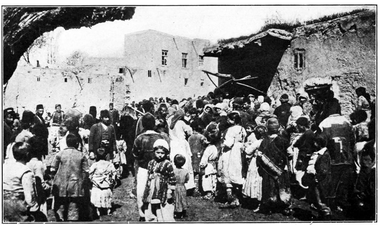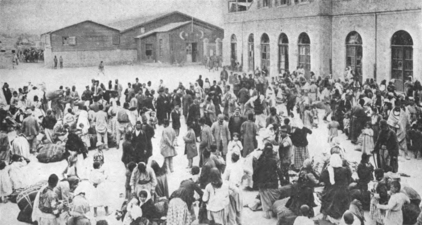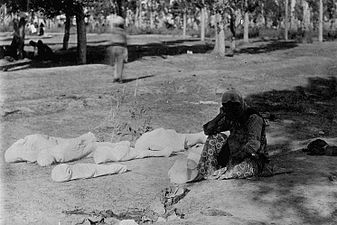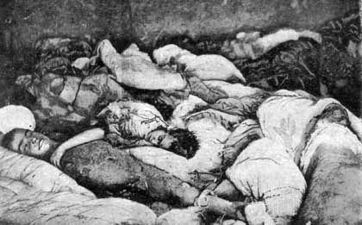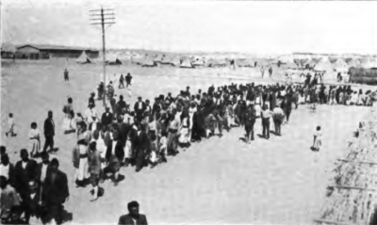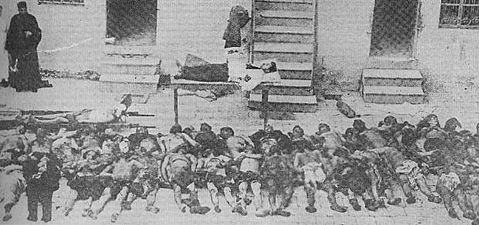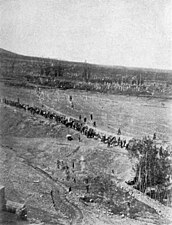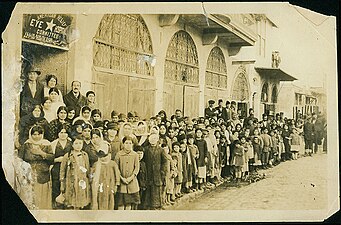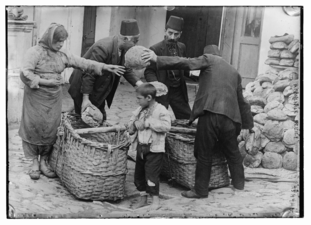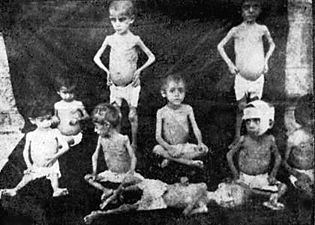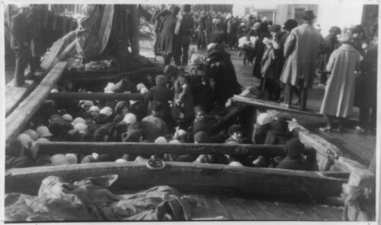Maangamizi ya Waarmenia


Maangamizi ya Waarmenia (kwa Kiarmenia Հայոց Ցեղասպանություն, Hayots Tseghaspanutyun) maarufu kwa Kiingereza kama Armenian Holocaust,[1], Armenian Massacres na kwa Kiarmenia Մեծ Եղեռն, Medz Yeghern, "Ovu kubwa")[2],[3] yalikuwa sera ya Dola la Osmani ya kukomesha Waarmenia wote walioishi ndani ya eneo la dola hilo (leo nchini Uturuki.
Makadirio ya waliouawa ni kati ya watu milioni 1 na 1.5.
Tarehe inayohesabiwa kuwa mwanzo wa hayo mauaji ya kimbari ni 24 Aprili 1915, ambapo watawala Waturuki waliteka wasomi Waarmenian 250 mjini Istanbul. Tarehe hiyohiyo miaka 100 baadaye yalifanyika maadhimisho makubwa katika nchi mbalimbalimbali, hasa huko Etchmiadzin, makao makuu ya kiroho ya Waarmenia, ambapo Patriarki Katolikosi Karekin II aliwatangaza kwa jumla waliouawa kuwa watakatifu wafiadini.
Maangamizi yalitekelezwa kwa awamu mbili: kwanza wanaume wazima waliuawa mara moja au kulazimishwa kufanya kazi za shokoa, halafu wanawake, watoto, wazee na wagonjwa waliswagwa na wanajeshi hadi jangwa la Syria ili wafe njiani, baada ya kunyimwa chakula, maji, mbali ya kuibiwa, kubakwa na kuuawa.[4][5][6]
Makabila mengine pia, hasa ya Kikristo, kama vile Waashuru na Wagiriki, waliangamizwa na Waturuki wakati huohuo.
Mtawanyiko wa Waarmenia duniani unatokana kwa kiasi kikubwa na mauaji hayo.
Vilevile ni kutokana nayo kwamba Raphael Lemkin alitunga neno genocide mwaka 1943 kama maangamizi ya halaiki ya mpango na kadiri ya sera.[7]
Maangamizi hayo yanahesabiwa ya kwanza katika karne ya 20[8][9][10] yakifuatwa na yale makubwa zaidi ya maangamizi makuu dhidi ya Wayahudi wa Ulaya chini ya Adolf Hitler.[11]
Uturuki, ulioshika nafasi ya Dola la Osmani, unazidi kukataa neno genocide kuhusiana na mauaji ya Waarmenia, ingawa wataalamu wengi wa historia wanaliona kuwa sahihi na nchi nyingi zaidi na zaidi zinaudai ukiri kosa na kupatana na Waarmenia.[12]
Picha
-
Waarmenia wakikimbia trenini
-
Waarmenia waliokatwa vichwa
-
Watoto wakimbizi huko Aleppo
-
Mwarmenia mwanamke akiteswa karibu na mtoto aliyeuawa
-
Askari wakicheza na mafuvu ya vichwa vya Waarmenia
-
Umati wa Waarmenia walioagizwa kukusanyika halafu wakaangamizwa
-
Mwanamke Mwarmenia akiwalilia watoto wake watano waliouawa
-
Uhamisho wa Waarmenia. Askari amewaibia.
-
Kambi la wakimbizi huko Syria
-
Maiti za watoto Waarmenia
-
Maiti huko Diyarbakir
-
Waarmenia wakinyongwa na Waturuki
-
Uhamisho wa Waarmenia katika wilaya ya Mamuret Al-Aziz
-
Uhamisho wa Waarmenia
-
Near East Relief na wakimbizi Waarmenia huko Bitlis
-
Mwanamke Mwarmenia na mwanae
-
Waarmenia waliokimbilia hospitali ya American Relief eye
-
Wakimbizi kwenye Near East relief
-
Ugawaji wa chakula
-
Mwanamke na mtoto
-
Kwenda Ugiriki
-
Watoto kwenye Near East Relief
-
Kwenda Ugiriki
-
Waarmenia waliokamatwa kabla hawajaangamizwa
Tanbihi
- ↑ Robert Fisk: Let me denounce genocide from the dock Ilihifadhiwa 24 Januari 2014 kwenye Wayback Machine. The Independent, 14 October 2006
- ↑ Armenian Genocide (affirmation), The International Association of Genocide Scholars,
That this assembly of the Association of Genocide Scholars in its conference held in Montreal, June 11–3, 1997, reaffirms that the mass murder of Armenians in Turkey in 1915 is a case of genocide which conforms to the statutes of the United Nations Convention on the Prevention and Punishment of Genocide. It further condemns the denial of the Armenian Genocide by the Turkish government and its official and unofficial agents and supporters.
- ↑ Matiossian, Vartan. "The Self-Delusion of 'Great Calamity': What 'Medz Yeghern' Actually Means Today", 12 January 2013.
- ↑ Kieser, Hans-Lukas; Schaller, Dominik J. (2002), Der Völkermord an den Armeniern und die Shoah (kwa German), Chronos, uk. 114, ISBN 3-0340-0561-X
{{citation}}: Unknown parameter|trans_title=ignored (|trans-title=suggested) (help)CS1 maint: unrecognized language (link) - ↑ Walker, Christopher J. (1980), Armenia: The Survival of A Nation, London: Croom Helm, ku. 200–3
- ↑ Bryce, Viscount James; Toynbee, Arnold (2000), Sarafian, Ara (mhr.), The Treatment of Armenians in the Ottoman Empire, 1915–1916: Documents Presented to Viscount Grey of Falloden (tol. la uncensored), Princeton, NJ: Gomidas, ku. 635–49, ISBN 0-9535191-5-5
- ↑ Hyde, Jennifer (2 Desemba 2008). "Polish Jew gave his life defining, fighting genocide". CNN. Ilihifadhiwa kwenye nyaraka kutoka chanzo mnamo 2008-12-03. Iliwekwa mnamo 2015-04-18.
{{cite journal}}: Cite journal requires|journal=(help); Unknown parameter|deadurl=ignored (|url-status=suggested) (help)CS1 maint: date auto-translated (link) - ↑ "Council of Europe Parliamentary Assembly Resolution". Armenian genocide.
- ↑ Ferguson, Niall (2006). The War of the World: Twentieth-Century Conflict and the Descent of the West. New York: Penguin Press. uk. 177. ISBN 1-59420-100-5.
- ↑ "A Letter from The International Association of Genocide Scholars" (PDF). Genocide Watch. 13 Juni 2005. Ilihifadhiwa kwenye nyaraka kutoka chanzo (PDF) mnamo 2017-10-11. Iliwekwa mnamo 2015-04-18.
{{cite journal}}: Cite journal requires|journal=(help); Unknown parameter|=ignored (help); Unknown parameter|dead-url=ignored (|url-status=suggested) (help)CS1 maint: date auto-translated (link) - ↑ Rummel, RJ (1 Aprili 1998), "The Holocaust in Comparative and Historical Perspective", The Journal of Social Issues, 3 (2)
{{citation}}: CS1 maint: date auto-translated (link) - ↑ "National Assembly of the Republic of Armenia - Official Web Site - parliament.am". parliament.am.
Marejeo
Historia
- Akçam, Taner. A Shameful Act: The Armenian Genocide and the Question of Turkish Responsibility. New York: Metropolitan Books, 2007.
- Akçam, Taner (2012). The Young Turks' Crime Against Humanity: The Armenian Genocide and Ethnic Cleansing in the Ottoman Empire. Princeton University Press. ISBN 9780691153339.
{{cite book}}: CS1 maint: ref duplicates default (link) - Balakian, Peter. The Burning Tigris: The Armenian Genocide and America's Response. New York: HarperCollins, 2003.
- Bloxham, Donald. The Great Game of Genocide: Imperialism, Nationalism, and the Destruction of the Ottoman Armenians. Oxford: Oxford University Press, 2005.
- Dadrian, Vahakn. The History of the Armenian Genocide: Ethnic Conflict from the Balkans to Anatolia to the Caucasus. Oxford: Berghahn Books, 1995.
- Dadrian, Vahakn. Warrant for Genocide: Key Elements of Turko-Armenian Conflict. New Brunswick, New Jersey: Transaction Publishers, 2003.
- Kévorkian, Raymond. The Armenian Genocide: A Complete History. London: I.B. Tauris, 2011.
- Suny, Ronald Grigor. "They Can Live in the Desert but Nowhere Else": A History of the Armenian Genocide. Princeton, NJ: Princeton University Press, 2015.
Masuala ya pekee na malinganisho
- Bobelian, Michael. Children of Armenia: A Forgotten Genocide and the Century-Long Struggle for Justice. New York: Simon & Schuster, 2009.
- Bonello, Giovanni (2008). Histories of Malta - Confessions and Transgressions, Vol.9. Fondazzjoni Patrimonju Malti. ISBN 978-99932-7-224-3. Ilihifadhiwa kwenye nyaraka kutoka chanzo mnamo 2018-07-10. Iliwekwa mnamo 2015-04-18.
{{cite book}}: CS1 maint: ref duplicates default (link) - Dadrian, Vahakn. "Genocide as a Problem of National and International Law: The World War I Armenian Case and its Contemporary Legal Ramifications", Yale Journal of International Law, Volume 14, Number 2, 1989.
- Dadrian, Vahakn. Key Elements in the Turkish Denial of the Armenian Genocide. Toronto: Zoryan Institute, 1999.
- Dadrian, Vahakn. "Patterns of Twentieth Century Genocides: the Armenian, Jewish, and Rwandan Cases". Journal of Genocide Research, 2004, 6 (4), pp. 487–522.
- Göçek, Fatma Müge. Denial of Violence: Ottoman Past, Turkish Present, and Collective Violence against the Armenians, 1789-2009. Oxford: Oxford University Press, 2014.
- Hovannisian, Richard (ed.) The Armenian Genocide: History, Politics, Ethics. New York: St. Martin's Press, 1992.
- Hovannisian, Richard. Remembrance and Denial: The Case of the Armenian Genocide. Detroit: Wayne State University Press, 1998.
- Hovannisian, Richard. The Armenian Genocide: Cultural and Ethical Legacies. New Brunswick, New Jersey: Transaction Publishers, 2007.
- Hovannisian, Richard G. and Simon Payalsian (eds). Armenian Cilicia. Costa Mesa, California: Mazda Publishers, 2008.
- Mann, Michael. The Dark Side of Democracy: Explaining Ethnic Cleansing. Cambridge, UK: Cambridge, UP, 2004.
- Melson, Robert, Revolution and Genocide: On the Origins of the Armenian Genocide and the Holocaust. Chicago: University of Chicago Press, 1996.
- Power, Samantha. "A Problem from Hell": America and the Age of Genocide. New York: Harper Perennial 2003.
- Sanasarian, Eliz (1989). "Gender Distinction in the Genocide Process: A Preliminary Study of the Armenian Case". Holocaust and Genocide Studies. 4 (4): 449–61. doi:10.1093/hgs/4.4.449. PMID 20684116.
- Üngör, Uğur Ümit (2011), The Making of Modern Turkey: Nation and State in Eastern Anatolia, 1913-1950, Oxford: Oxford University Press.
Ushahidi wa walionusurika
- Balakian, Grigoris. Armenian Golgotha. Translated by Peter Balakian with Aris Sevag. New York: Alfred A. Knopf, 2009.
- Bedoukian, Kerop. Some of Us Survived: The Story of an Armenian Boy. New York: Farrar Straus Giroux, 1978.
- Hartunian, Abraham H. Neither to Laugh nor to Weep: A Memoir of the Armenian Genocide. Translated by Vartan Hartunian. Cambridge, MA: Armenian Heritage Press, 1986.
- Jacobsen, Maria. Diaries of a Danish missionary: Harpoot, 1907–1919. Princeton: Gomidas Institute, 2001.
- Lang, David Marshall. The Armenians: A People in Exile. London: Allen & Unwin, 1981.
- Miller, Donald E. and Lorna Touryan Miller. Survivors: An Oral History of the Armenian Genocide. Berkeley: University of California Press, 1993.
- Panian, Karnig. Goodbye, Antoura: A Memoir of the Armenian Genocide. Stanford, CA: Stanford University Press, 2015.
- Odian, Yervant. Accursed Years: My Exile and Return from Der Zor, 1914–1919. Translated by Ara Stepan Melkonyan. London: Taderon Press, 2009.
- Svazlyan, Verzhine. The Armenian Genocide and Historical Memory. Translated by Tigran Tsulikian. Yerevan: Gitutiun Publishing House, 2004.
Jumuia za zamani za Waarmenia
- Hovannisian, Richard. Armenian Van/Vaspurakan. Costa Mesa, California: Mazda Publishers, 2000.
- Hovannisian, Richard. Armenian Baghesh/Bitlis and Taron/Mush. Costa Mesa, California: Mazda Publishers, 2001.
- Hovannisian, Richard. Armenian Karin/Erzerum. Costa Mesa, California: Mazda Publishers, 2003.
- Hovannisian, Richard. Armenian Sebastia/Sivas and Lesser Armenia. Costa Mesa, California: Mazda Publishers, 2004.
Itikio la ulimwengu na ushahidi wa watu wa nje
- Anderson, Margaret Lavinia. "'Down in Turkey, far away': Human Rights, the Armenian Massacres, and Orientalism in Wilhelmine Germany", Journal of Modern History Volume, 79, Number 1, March 2007, pp. 80–111. in JSTOR
- Barton, James L. Turkish Atrocities: Statements of American Missionaries on the Destruction of Christian Communities in Ottoman Turkey, 1915–1917. Ann Arbor: Gomidas Institute, 1997.
- Bryce, James and Arnold Toynbee. The Treatment of Armenians in the Ottoman Empire, 1915–1916: Documents Presented to Viscount Grey of Falloden, Uncensored ed. Edited and with an introduction by Ara Sarafian. Princeton: Gomidas Institute, 2000. complete text
- Dadrian, Vahakn N. Documentation of the Armenian Genocide in Turkish Sources. Jerusalem: Institute on the Holocaust and Genocide, 1991.
- Davis, Leslie A. The Slaughterhouse Province: An American Diplomat's Report on the Armenian Genocide, 1915–1917. ew Rochelle, N.Y.: A.D. Caratzas, 1989.
- Hovannisian, Richard G. "The Allies and Armenia, 1915–18". Journal of Contemporary History 1968 3(1): 145–168. ISSN: 0022-0094 Fulltext: in Jstor
- Libaridian, Gerard. "The Ideology of the Young Turk Movement", pp. 37–49. In Gerard Libaridian (Ed.) A Crime of Silence, The Armenian Genocide: Permanent Peoples' Tribunal. London: Zed Books, 1985.
- Morgenthau, Henry (1918), Ambassador Morgenthau's Story (Google Books excerpt and text search).
- Nassibian, Akaby (1984), Britain and the Armenian Question: 1915–1923, New York: St. Martin's Press.
- Peterson, Merrill D (2004), "Starving Armenians": America and the Armenian Genocide, 1915–1930 and After, Charlottesville: University of Virginia Press.
- Power, Samantha (2003), "A Problem from Hell": America and the Age of Genocide, Harper.
- Severance, Gordon; Severance, Diana (2003), Against the Gates of Hell: The Life & Times of Henry Perry, a Christian Missionary in a Moslem World.
- Safarian, Ara, mhr. (2004), United States Official Documents on the Armenian Genocide, 1915–1917, Princeton, New Jersey: Gomidas.
- Winter, Jay, mhr. (2004), America and the Armenian Genocide of 1915 (Google Books excerpts and text search), ISBN 9781139450188, 325 pp.
Kumbukumbu na vitabu
- Auron, Yair [Oron, Ya'ir] (2005) [2003], The Banality of Denial: Israel and the Armenian Genocide, Transaction
{{citation}}: CS1 maint: multiple names: authors list (link). - Bevan, Robert (2006), "Cultural Cleansing: Who Remembers the Armenians?", The Destruction of Memory: Architecture at War, ku. 25–60, ISBN 1861893191.
- Gunter, Michael M (1986), Pursuing the Just Cause of Their People: A Study of Contemporary Armenian Terrorism, Questia
- Hovannisian, Richard G, mhr. (1999), Remembrance and Denial: The Case of the Armenian Genocide, 316 pp.
- Melson, Robert (1982), "A Theoretical Inquiry into the Armenian Massacres of 1894–1896", Comparative Studies in Society and History, 24 (3): 481–509, doi:10.1017/S0010417500010100.
- ——— (1989), "Revolutionary Genocide: On the causes of the Armenian genocide of 1915 and the Holocaust", Holocaust and Genocide Studies, 4 (2), Hein online: 161–74, doi:10.1093/hgs/4.2.161.
- Peroomian, Rubina (1993), Literary Responses to Catastrophe: A Comparison of the Armenian and the Jewish Experience.
Viungo vya nje
- The Armenian Genocide Institute-Museum, Yerevan, AM.
- Armenian National Institute, Washington, D.C. (dedicated to the study, research, and affirmation of the Armenian Genocide).
- Armenian Genocide Debate.
- The Forgotten, ilihifadhiwa kwenye nyaraka kutoka chanzo mnamo 2022-02-11, iliwekwa mnamo 2015-04-18
{{citation}}: Unknown parameter|dead-url=ignored (|url-status=suggested) (help), videos of interviews with survivors. - "Armenians 1915", Armenian Genocide Research Center (World Wide Web log), Google Bogger.
- "Fall of the Ottoman Empire", Online Encyclopedia of Mass violence (chronological index & articles).
- Genocide, AM, ilihifadhiwa kwenye nyaraka kutoka chanzo mnamo 2020-12-05, iliwekwa mnamo 2015-04-18
{{citation}}: Unknown parameter|dead-url=ignored (|url-status=suggested) (help). - "Screamers", You tube (video) (documentary), Google, about genocide, featuring System of a Down.
- Tavernise, Sabrina, "Armenian Genocide", The New York Times (collected news and coverage).
- Pope John Paul II and Pope Francis on the Armenian Genocide
| Makala hii kuhusu mambo ya kihistoria bado ni mbegu. Je, unajua kitu kuhusu Maangamizi ya Waarmenia kama enzi zake au matokeo yake? Labda unaona habari katika Wikipedia ya Kiingereza au lugha nyingine zinazofaa kutafsiriwa? Basi unaweza kuisaidia Wikipedia kwa kuihariri na kuongeza habari. |
- CS1 errors: unsupported parameter
- CS1 maint: unrecognized language
- CS1 errors: missing periodical
- CS1 maint: date auto-translated
- CS1 maint: ref duplicates default
- CS1 maint: multiple names: authors list
- Mbegu za historia
- Historia ya Armenia
- Historia ya Uturuki
- Mauaji ya kimbari
- Wafiadini Wakristo
- Dhuluma za dini
- Watakatifu wa Armenia
- Watakatifu wa Uturuki



